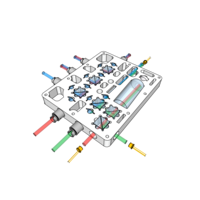Abstract
Novel quantum technologies and devices place unprecedented demands on the performance of experimental components, while their widespread deployment beyond the laboratory necessitates increased robustness and fast affordable production. We show how the use of additive manufacturing, together with mathematical optimization techniques and innovative designs, allows the production of compact lightweight components with greatly enhanced performance. We use such components to produce a magneto-optical trap that captures approximately rubidium atoms, employing for this purpose a compact and highly stable device for spectroscopy and optical power distribution, optimized neodymium magnet arrays for magnetic field generation, and a lightweight additively manufactured ultrahigh-vacuum chamber. We show how the use of additive manufacturing enables substantial weight reduction and stability enhancement, while also illustrating the transferability of our approach to experiments and devices across the quantum technology sector and beyond.
4 More- Received 2 March 2021
- Accepted 28 June 2021
DOI:https://doi.org/10.1103/PRXQuantum.2.030326
Published by the American Physical Society under the terms of the Creative Commons Attribution 4.0 International license. Further distribution of this work must maintain attribution to the author(s) and the published article's title, journal citation, and DOI.
Published by the American Physical Society
Physics Subject Headings (PhySH)
 synopsis
synopsis
3D-Printed Components for Cold Atoms
Published 12 August 2021
Researchers demonstrate lighter, smaller optics and vacuum components for cold-atom experiments that they hope could enable the development of portable quantum technologies.
See more in Physics
Popular Summary
Quantum technologies are set to have a dramatic impact on both science and society, transforming fields as diverse as brain imaging, geophysical surveying, and space-borne fundamental-physics experiments. However, the hardware upon which these technologies depend is typically large, expensive, difficult to use, and highly susceptible to environmental noise. To enable the widespread rollout of quantum technologies, the required hardware must become more portable, cheaper, and more robust. We demonstrate a range of quantum technology hardware components with improved robustness and greatly reduced size and weight. Furthermore, we use these components to illustrate a more general experimental design methodology, which can be applied to numerous quantum technology components across a wide range of disciplines.
The principle that underpins our new components is the use of additive manufacturing (AM) to directly implement the results of design and optimization processes, freeing components from the constraints imposed by conventional manufacturing. This enables rapid device prototyping and dramatic reductions in size and weight. Reduced system size typically then leads to improved robustness against environmental disturbance. The customizability afforded by AM, together with the increased component alignment tolerances resulting from reduced overall system size, also enables the elimination of many adjustable components from conventional systems; this improves stability, decreases requirements on user expertise, and further reduces size and weight.
It is expected that these results will establish a new paradigm for experimental design, particularly in the area of free-space optics, and to facilitate the development of smaller, cheaper, more robust quantum devices, both inside and outside the laboratory.




